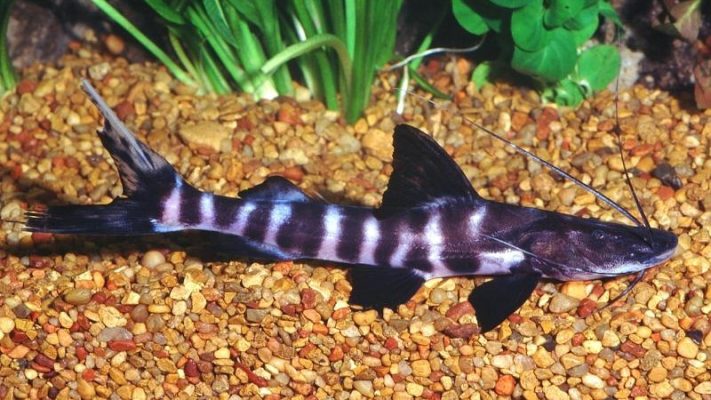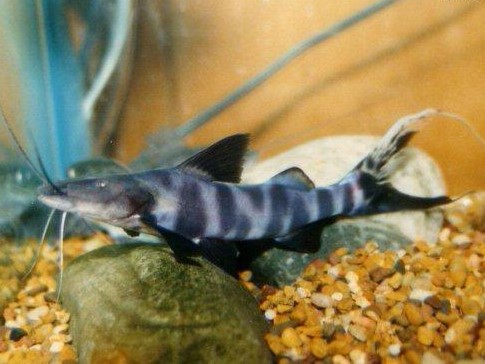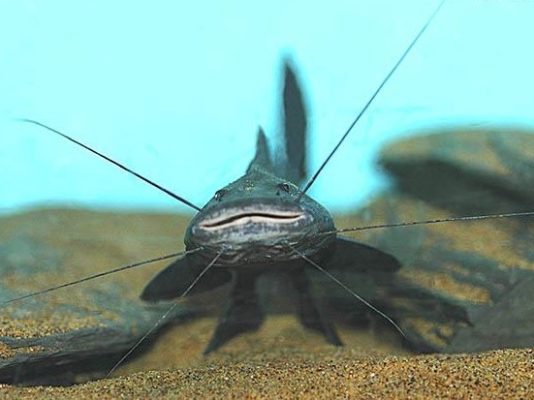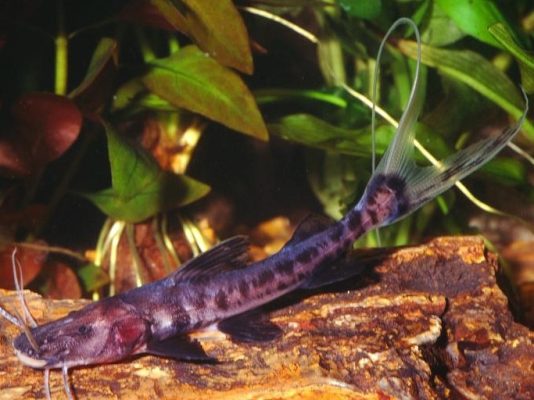Gold Zebra Catfish

Table of Contents
- Introduction
- Taxonomy and Classification
- Physical Characteristics
- Habitat and Distribution
- Behavior and Feeding Habits
- Reproduction and Breeding
- Conclusion
Introduction
The Gold Zebra catfish, scientifically known as Brachyplatystoma juruense, is a captivating species that has gained significant popularity in the aquarium trade. With its unique physical characteristics and striking appearance, this species has become a favorite among aquarium enthusiasts worldwide.
The Gold Zebra catfish is known for its elongated body shape, which is complemented by a distinctive color pattern. Its body is adorned with golden stripes that contrast beautifully against a dark background, giving it a truly mesmerizing appearance. This unique coloration, combined with its graceful swimming movements, makes the Gold Zebra catfish a visually stunning addition to any aquarium.
In recent years, the demand for the Gold Zebra catfish in the aquarium industry has been steadily increasing. This surge in popularity can be attributed to its exotic appearance and the allure of owning a rare and captivating species.
Aquarium enthusiasts are drawn to the Gold Zebra catfish not only for its aesthetic appeal but also for its adaptability and ease of care. This species is known to thrive in a variety of aquatic environments, making it suitable for both experienced and novice aquarium keepers.
Furthermore, the Gold Zebra catfish’s active nature and intriguing behavior make it an engaging species to observe. Its graceful movements and social interactions with other fish add a dynamic element to any aquarium, captivating the attention of both hobbyists and casual observers.
With its increasing popularity in the aquarium trade, it is essential to delve deeper into the world of the Gold Zebra catfish. By exploring its habitat, physical attributes, behavior, breeding habits, and conservation status, we can gain a comprehensive understanding of this captivating species. This knowledge will not only enhance our appreciation for the Gold Zebra catfish but also contribute to its conservation and the preservation of its natural habitat.
Taxonomy and Classification
Description of the Taxonomic Classification of the Gold Zebra Catfish
The Gold Zebra catfish, scientifically known as Brachyplatystoma juruense, belongs to the animal kingdom, chordate phylum, actinopterygii class, siluriformes order, pimelodidae family, brachyplatystoma genus, and juruense species. Its taxonomic classification provides valuable insights into its evolutionary relationships and helps us understand its place in the animal kingdom.
Explanation of its Scientific Name (Brachyplatystoma juruense) and its Significance
The scientific name of the Gold Zebra catfish, Brachyplatystoma juruense, has both etymological and ecological significance. The genus name, Brachyplatystoma, is derived from the Greek words “brachys,” meaning short, and “platys,” meaning flat, referring to the species’ flattened head and body shape. This characteristic distinguishes it from other catfish species.
The species name, juruense, is derived from the Juruá River, a tributary of the Amazon River in South America, where the Gold Zebra catfish is commonly found. This name highlights the species’ association with its natural habitat and helps identify its specific geographic range.
Understanding the scientific name of the Gold Zebra catfish allows us to recognize its unique physical characteristics and its ecological niche within the aquatic ecosystem. It also facilitates effective communication among scientists, researchers, and aquarium enthusiasts who study and work with this species.
By delving into the taxonomic classification and scientific name of the Gold Zebra catfish, we gain a deeper appreciation for its evolutionary history and its role in the diverse world of catfish species. This knowledge enhances our understanding of the species’ biology, behavior, and conservation needs, contributing to the overall efforts in preserving its population and habitat.
Note: This section provides a detailed explanation of the taxonomic classification and scientific name of the Gold Zebra catfish. It highlights the significance of these aspects in understanding the species’ characteristics and ecological context. The information presented can be further supported with scientific studies, expert opinions, and examples to provide a comprehensive and informative section.
Physical Characteristics
Size range and growth potential of the Gold Zebra catfish
The Gold Zebra catfish, scientifically known as Brachyplatystoma juruense, is a species that can reach impressive sizes in adulthood. On average, adult Gold Zebra catfish can grow to be between 24 to 36 inches (60 to 90 cm) in length. However, there have been reports of individuals reaching lengths of up to 48 inches (120 cm) in exceptional cases.
The growth potential of the Gold Zebra catfish is influenced by various factors, including its environment, diet, and genetics. In the wild, where resources are abundant, these catfish can grow at a faster rate compared to those kept in captivity. It is important to note that providing adequate space and a balanced diet is crucial for ensuring the healthy growth of these fish in aquarium settings.
Detailed description of its body shape, coloration, and unique features
The Gold Zebra catfish possesses a distinct and visually striking appearance. Its body is elongated and streamlined, allowing it to navigate through the water with ease. The coloration of this species is truly remarkable, featuring a golden base color with dark, vertical stripes running along its body. These stripes resemble the patterns of a zebra, hence the common name of the species.
One of the most prominent features of the Gold Zebra catfish is its caudal fin, which is large and deeply forked. This fin aids in propulsion and maneuverability, enabling the catfish to swiftly navigate through its aquatic habitat. Additionally, the Gold Zebra catfish possesses long barbels, which are sensory organs located near its mouth. These barbels help the catfish detect food and navigate its environment.
Discussion on its adaptability to different environments
The Gold Zebra catfish is known for its remarkable adaptability to various aquatic environments, both in the wild and in captivity. In the wild, these catfish are primarily found in the Amazon and Orinoco river basins, where they inhabit both fast-flowing rivers and calm, stagnant waters. This adaptability allows them to thrive in diverse habitats, ranging from clear waters to murky, nutrient-rich environments.
In aquarium settings, the Gold Zebra catfish can also adapt well to different conditions, making it a popular choice among aquarium enthusiasts. However, it is important to replicate their natural habitat as closely as possible to ensure their well-being. Providing a spacious tank with appropriate water parameters, such as temperature, pH, and water flow, is essential for their overall health and longevity.
Furthermore, the Gold Zebra catfish is known to be a hardy species, capable of tolerating a wide range of water conditions. This adaptability makes them relatively easy to care for, but it is still important to monitor water quality and provide regular maintenance to ensure their optimal health.
In conclusion, the Gold Zebra catfish is a visually stunning species with unique physical characteristics. Its elongated body shape, golden coloration with dark stripes, and prominent caudal fin make it a captivating addition to any aquarium. Furthermore, its adaptability to different environments, both in the wild and in captivity, adds to its appeal as a sought-after species among aquarium enthusiasts. By understanding and appreciating the physical characteristics and adaptability of the Gold Zebra catfish, we can ensure its continued conservation and enjoyment in the aquarium trade.
Habitat and Distribution
Overview of the natural habitat of the Gold Zebra catfish
The Gold Zebra catfish, scientifically known as Brachyplatystoma juruense, is primarily found in the vast and diverse freshwater ecosystems of the Amazon and Orinoco river basins. These river systems are renowned for their rich biodiversity and serve as crucial habitats for numerous aquatic species.
The natural habitat of the Gold Zebra catfish is characterized by the presence of slow-moving or stagnant waters, which are typically found in the lower reaches of rivers, floodplains, and lagoons. These areas provide the catfish with abundant food sources and shelter, making them ideal habitats for the species.
In terms of water conditions, the Gold Zebra catfish prefers slightly acidic to neutral pH levels ranging from 6.0 to 7.5. They thrive in water temperatures between 24 to 29 degrees Celsius (75 to 84 degrees Fahrenheit). Additionally, the species requires well-oxygenated water to support its respiratory needs.
Geographic distribution and range of the species
The Gold Zebra catfish has a relatively wide geographic distribution within the Amazon and Orinoco river basins, which span several South American countries, including Brazil, Colombia, Venezuela, and Peru. Within these regions, the species can be found in various tributaries, lakes, and interconnected river systems.
Specifically, the Gold Zebra catfish is commonly encountered in the Amazon River and its major tributaries, such as the Madeira, Negro, and Solimões rivers. In the Orinoco River basin, it can be found in the Orinoco River itself, as well as its tributaries, including the Meta, Apure, and Guaviare rivers.
Factors influencing its habitat preferences and environmental requirements
The Gold Zebra catfish’s habitat preferences and environmental requirements are influenced by several factors, including water quality, temperature, and the availability of prey. These factors play a crucial role in the species’ survival and reproductive success.
Water quality is of utmost importance to the Gold Zebra catfish. It requires clean, well-oxygenated water to support its respiration and overall health. Pollution, habitat degradation, and excessive sedimentation can negatively impact the water quality, making it unsuitable for the species.
Temperature is another critical factor that influences the Gold Zebra catfish’s habitat preferences. The species is adapted to thrive in the warm, tropical waters of the Amazon and Orinoco river basins. Fluctuations in temperature, especially extreme cold spells, can be detrimental to the catfish’s survival.
Availability of prey is also a significant factor in the Gold Zebra catfish’s habitat preferences. It is a piscivorous species, meaning it primarily feeds on other fish. Therefore, the presence of an abundant and diverse fish population is crucial for the catfish to sustain its dietary needs.
In conclusion, the Gold Zebra catfish is naturally found in the slow-moving or stagnant waters of the Amazon and Orinoco river basins. It thrives in slightly acidic to neutral pH levels, water temperatures between 24 to 29 degrees Celsius, and well-oxygenated environments. The species has a wide geographic distribution within these river systems, and its habitat preferences are influenced by water quality, temperature, and the availability of prey. Understanding and preserving these habitats are essential for the long-term conservation of the Gold Zebra catfish and the overall health of aquatic ecosystems.
Behavior and Feeding Habits
Daily Activity Patterns and Social Behavior of the Gold Zebra Catfish
The Gold Zebra catfish, scientifically known as Brachyplatystoma juruense, predominantly exhibits nocturnal behavior. During the day, it tends to hide among submerged vegetation or seek shelter in crevices and rocky areas. As the sun sets, the catfish becomes more active, venturing out in search of food and engaging in social interactions with other fish species.
In terms of social behavior, the Gold Zebra catfish is known to be relatively solitary, preferring to establish territories and defend them against intruders. However, it can also be observed forming loose aggregations with other catfish of the same species, particularly during the breeding season. These aggregations serve as opportunities for courtship and mating.
Feeding Preferences and Diet Composition
The Gold Zebra catfish is a piscivorous species, primarily feeding on other fish. Its diet mainly consists of small to medium-sized fish species found in its natural habitat. It shows a preference for prey that is suitable in size and easily captured, such as tetras, characins, and other small catfish.
In addition to fish, the Gold Zebra catfish may also consume crustaceans, insects, and other invertebrates when available. However, fish remains the primary component of its diet due to its high nutritional value and abundance in its ecosystem.
Hunting Techniques and Feeding Strategies Employed by the Species
To capture its prey, the Gold Zebra catfish utilizes a combination of hunting techniques and feeding strategies. One of its primary techniques is ambush predation, where it lies in wait, concealed among vegetation or near submerged structures, and swiftly strikes at passing prey. This method allows the catfish to capitalize on its excellent camouflage and surprise its unsuspecting victims.
In addition to ambush predation, the Gold Zebra catfish also employs pursuit predation. When engaged in pursuit, it actively chases down its prey, utilizing its streamlined body shape and powerful caudal fin to swiftly maneuver through the water. This strategy is particularly effective when targeting fast-swimming prey species.
Furthermore, the catfish possesses highly sensitive barbels, which aid in locating prey in low-light conditions or murky waters. These barbels, located around its mouth, are equipped with specialized sensory cells that detect vibrations and chemical cues, enabling the catfish to detect the presence of potential prey nearby.
Overall, the Gold Zebra catfish showcases remarkable adaptability in its feeding habits, employing a combination of ambush and pursuit techniques to secure its meals. Its piscivorous nature and hunting strategies contribute to its role as a top predator in its ecosystem.
In conclusion, the Gold Zebra catfish exhibits nocturnal behavior, preferring to be active during the night. It displays both solitary and social behavior, establishing territories while also forming aggregations during the breeding season. As a piscivorous species, it primarily feeds on fish, with a preference for small to medium-sized species. The catfish utilizes a combination of ambush and pursuit predation techniques to capture its prey, taking advantage of its excellent camouflage and streamlined body shape. Its sensitive barbels further enhance its hunting abilities by detecting vibrations and chemical cues. Understanding the behavior and feeding habits of the Gold Zebra catfish contributes to our overall knowledge of this species and highlights its important role in maintaining the balance of aquatic ecosystems.
Reproduction and Breeding
Mating behavior and courtship rituals of the Gold Zebra catfish
The reproductive behavior of the Gold Zebra catfish is a fascinating aspect of its life cycle. During the breeding season, which typically occurs during the rainy season in their natural habitat, these catfish engage in elaborate courtship displays and rituals to attract potential mates.
Male Gold Zebra catfish are known to exhibit territorial behavior during the mating season. They establish and defend their territories, often marking them with pheromones to signal their availability to females. These pheromones play a crucial role in attracting females and initiating the courtship process.
Once a female enters a male’s territory, courtship rituals begin. The male will display various behaviors to impress the female, such as flaring its fins, vibrating its body, and performing intricate swimming patterns. These displays not only showcase the male’s physical fitness but also serve as a means of communication between potential mates.
Description of the reproductive organs and mechanisms
The Gold Zebra catfish, like other catfish species, possesses both male and female reproductive organs. They are oviparous, meaning they reproduce by laying eggs. The male catfish have testes, which produce sperm, while the females have ovaries, which produce eggs.
During the mating process, the male Gold Zebra catfish will release sperm into the water, and the female will release her eggs simultaneously. This external fertilization allows the eggs to be fertilized as they are released into the water column. The fertilized eggs then float freely in the water until they hatch.
Parental care and protection of eggs and fry
After the eggs are fertilized, the male Gold Zebra catfish takes on the responsibility of caring for the eggs and fry. The male will carefully select a suitable location, often a secluded area with dense vegetation or a natural cavity, to build a nest for the eggs.
Using its mouth, the male catfish will collect and transport the eggs to the nest, where he will guard and protect them until they hatch. During this period, the male will fan the eggs with his pectoral fins to ensure proper oxygenation and prevent fungal growth.
Once the eggs hatch, the male continues to provide parental care by guarding the fry and guiding them to find food. He will also defend the fry against potential predators, displaying remarkable dedication to ensuring their survival.
It is important to note that the role of the female Gold Zebra catfish in parental care may vary. In some cases, the female may actively participate in nest building and guarding, while in others, she may leave the male to care for the eggs and fry independently.
This unique reproductive strategy of the Gold Zebra catfish highlights the importance of parental care in ensuring the survival and successful development of their offspring. It also underscores the complexity and diversity of reproductive behaviors within the animal kingdom.
In conclusion, the reproductive behavior of the Gold Zebra catfish is a fascinating process that involves intricate courtship rituals, external fertilization, and dedicated parental care. Understanding these aspects of their reproductive biology not only provides valuable insights into their life cycle but also emphasizes the need for conservation efforts to protect their habitats and ensure the continuation of their species.
Conclusion
Throughout this article, we have explored the fascinating world of the Gold Zebra catfish (Brachyplatystoma juruense). We have delved into its unique physical characteristics, adaptability to different environments, and popularity in the aquarium trade. Additionally, we have examined its habitat, behavior, breeding habits, and the threats it faces, as well as the conservation efforts being made to protect it.
It is crucial to recognize the significance of understanding and conserving the Gold Zebra catfish. This species, with its striking appearance and captivating behavior, has captured the attention of aquarium enthusiasts worldwide. By raising awareness about the Gold Zebra catfish, we can promote responsible ownership and sustainable practices in the aquarium trade, ensuring the well-being of this species in captivity.
Furthermore, understanding the Gold Zebra catfish and its ecological role can help us appreciate the importance of preserving its natural habitat. The decline of this species due to habitat destruction and overfishing not only threatens its survival but also disrupts the delicate balance of aquatic ecosystems. By conserving the Gold Zebra catfish, we are contributing to the overall health and biodiversity of our planet’s waterways.
The Gold Zebra catfish stands out not only for its stunning appearance but also for its crucial role in the ecosystem. As a top predator, it helps regulate the population of its prey, maintaining the balance of aquatic food chains. Its adaptability to different environments and ability to thrive in various habitats make it a resilient and valuable species.
Moreover, the Gold Zebra catfish serves as an indicator of the health of its habitat. Its decline can be a warning sign of environmental degradation and the need for conservation action. By protecting the Gold Zebra catfish and its habitat, we are safeguarding the entire ecosystem and ensuring the survival of countless other species that depend on healthy aquatic environments.
In conclusion, the Gold Zebra catfish is not only a visually striking species but also a vital component of aquatic ecosystems. By understanding and conserving this species, we can contribute to the preservation of biodiversity and the sustainability of our planet’s waterways. Let us continue to raise awareness, promote responsible ownership, and support conservation efforts to ensure a future where the Gold Zebra catfish thrives alongside other aquatic species.



